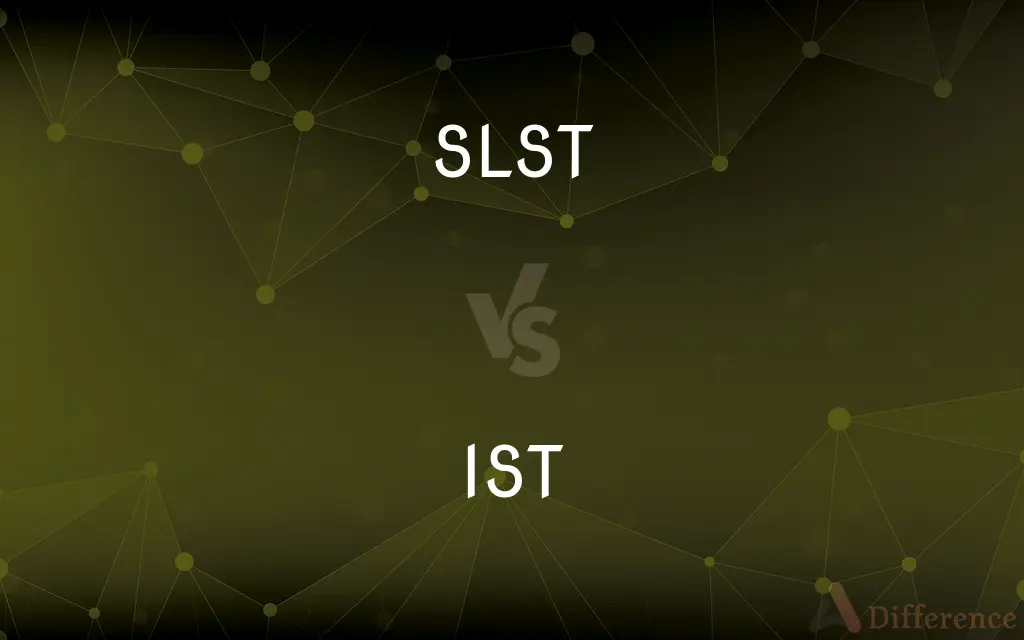SLST vs. IST — What's the Difference?
By Maham Liaqat & Urooj Arif — Published on February 22, 2024
SLST (Sri Lanka Standard Time) is the time zone for Sri Lanka, fixed at UTC+5:30, while IST (Indian Standard Time) also operates at UTC+5:30, serving as the time zone for India.

Difference Between SLST and IST
Table of Contents
ADVERTISEMENT
Key Differences
SLST and IST share the same offset from Coordinated Universal Time (UTC+5:30), making them identical in terms of the hours and minutes displayed on clocks. However, their application is distinct, tied to their respective countries: Sri Lanka for SLST and India for IST. This means that while the time readout is the same in both zones, the designation is used to reference the specific national standard time of these neighboring countries.
The adoption of the same time zone underscores the geographical and historical connections between India and Sri Lanka, yet each country chooses to label its standard time according to its national identity. Despite the shared time offset, there may be differences in how each country implements daylight saving time (DST) adjustments, although traditionally, neither India nor Sri Lanka observes DST, maintaining a consistent UTC+5:30 throughout the year.
In a global context, the naming of time zones like SLST and IST highlights the importance of national identity in timekeeping standards. This distinction is crucial for international relations, scheduling, and digital communications, where precise time labeling ensures clarity and coordination across borders.
For travelers and businesses operating in or between Sri Lanka and India, understanding that SLST and IST refer to the same time offset but different national jurisdictions helps in planning and communication. The shared time zone simplifies scheduling across these locations, reducing the potential for confusion in international engagements.
Ultimately, while SLST and IST might appear redundant due to their identical time offsets, their existence as separate entities emphasizes the sovereignty and distinct identities of Sri Lanka and India, respectively. This separation ensures that national standards are maintained and respected in global discourse and transactions.
ADVERTISEMENT
Comparison Chart
Offset from UTC
UTC+5:30
UTC+5:30
Country
Sri Lanka
India
Daylight Saving Time
Not observed
Not observed
Purpose
Serves as the national standard time for Sri Lanka
Serves as the national standard time for India
Global Position
Reflects Sri Lanka's position in the global time zone system
Reflects India's position in the global time zone system
Compare with Definitions
SLST
Does not observe daylight saving time.
SLST remains constant throughout the year, without adjustment for daylight saving.
IST
Central to India's national scheduling.
IST dictates the timing for all of India's national broadcasts and events.
SLST
Reflects Sri Lanka's geographical and cultural identity.
SLST ensures national events are synchronized across the island.
IST
Consistently applied across India without DST.
IST does not change, eliminating the need for seasonal time adjustments.
SLST
Used exclusively within Sri Lanka.
All official times in Sri Lanka are recorded in SLST.
IST
The standard time zone for India, also set at UTC+5:30.
Mumbai and New Delhi follow IST year-round.
SLST
The time zone used in Sri Lanka, fixed at UTC+5:30.
Colombo operates on SLST, aligning with UTC+5:30.
IST
A unifying standard for the diverse regions of India.
Despite its vast size, all of India operates under IST.
SLST
Identical to IST in terms of numerical time offset.
SLST and IST share the same time offset, making them interchangeable in scheduling.
IST
Shares its time offset with SLST, highlighting regional timekeeping coherence.
IST and SLST's shared offset facilitates cross-border coordination.
Common Curiosities
What is the main difference between SLST and IST?
The main difference is geographical: SLST is the standard time for Sri Lanka, while IST is for India, despite both being at UTC+5:30.
Why do Sri Lanka and India use different names for the same time zone?
The different names reflect each country's national identity and standard timekeeping practices.
Can SLST and IST be considered interchangeable?
Yes, in terms of scheduling and timekeeping, they are interchangeable due to their identical time offset, but it's important to use the correct designation for clarity in international communication.
How do travelers adjust to SLST and IST?
Travelers to Sri Lanka or India must set their watches to UTC+5:30, with no need for further adjustment between these countries.
Do SLST and IST have any difference in time offset?
No, both SLST and IST are set at UTC+5:30, with no difference in the time offset.
Do SLST and IST observe daylight saving time?
Neither SLST nor IST observes daylight saving time, maintaining a consistent UTC+5:30 throughout the year.
How do SLST and IST impact international business?
They simplify scheduling and operations between Sri Lanka and India by sharing the same time offset, enhancing regional cooperation.
Are there any global implications of having separate time zones with the same offset?
It emphasizes the importance of national identity in global timekeeping, requiring precise communication in international affairs.
What role does the shared time offset play in Sri Lanka-India relations?
It facilitates easier communication and coordination for travel, business, and diplomatic engagements between the two countries.
What would happen if one country changes its standard time?
It would affect scheduling and coordination between Sri Lanka and India, necessitating adjustments in international and cross-border engagements.
How do SLST and IST affect daily life in Sri Lanka and India?
They standardize time across each country, simplifying daily schedules, transportation, and business operations.
Is there any historical reason for the shared time offset between SLST and IST?
The shared offset reflects geographical proximity and historical connections, but the separate designations respect each country's sovereignty.
Why is it important for countries to have their own standard time?
It allows for uniformity in legal, commercial, and social activities within the country, reinforcing national identity and operational coherence.
How are SLST and IST determined and regulated?
Each country's government determines and regulates its standard time, often through national observatories or timekeeping agencies.
What is the significance of not observing DST in SLST and IST zones?
It provides stability and predictability in timekeeping throughout the year, essential for both domestic and international coordination.
Share Your Discovery

Previous Comparison
Sri Lanka Standard Time vs. Indian Standard Time
Next Comparison
Protic Solvents vs. Aprotic SolventsAuthor Spotlight
Written by
Maham LiaqatCo-written by
Urooj ArifUrooj is a skilled content writer at Ask Difference, known for her exceptional ability to simplify complex topics into engaging and informative content. With a passion for research and a flair for clear, concise writing, she consistently delivers articles that resonate with our diverse audience.
















































